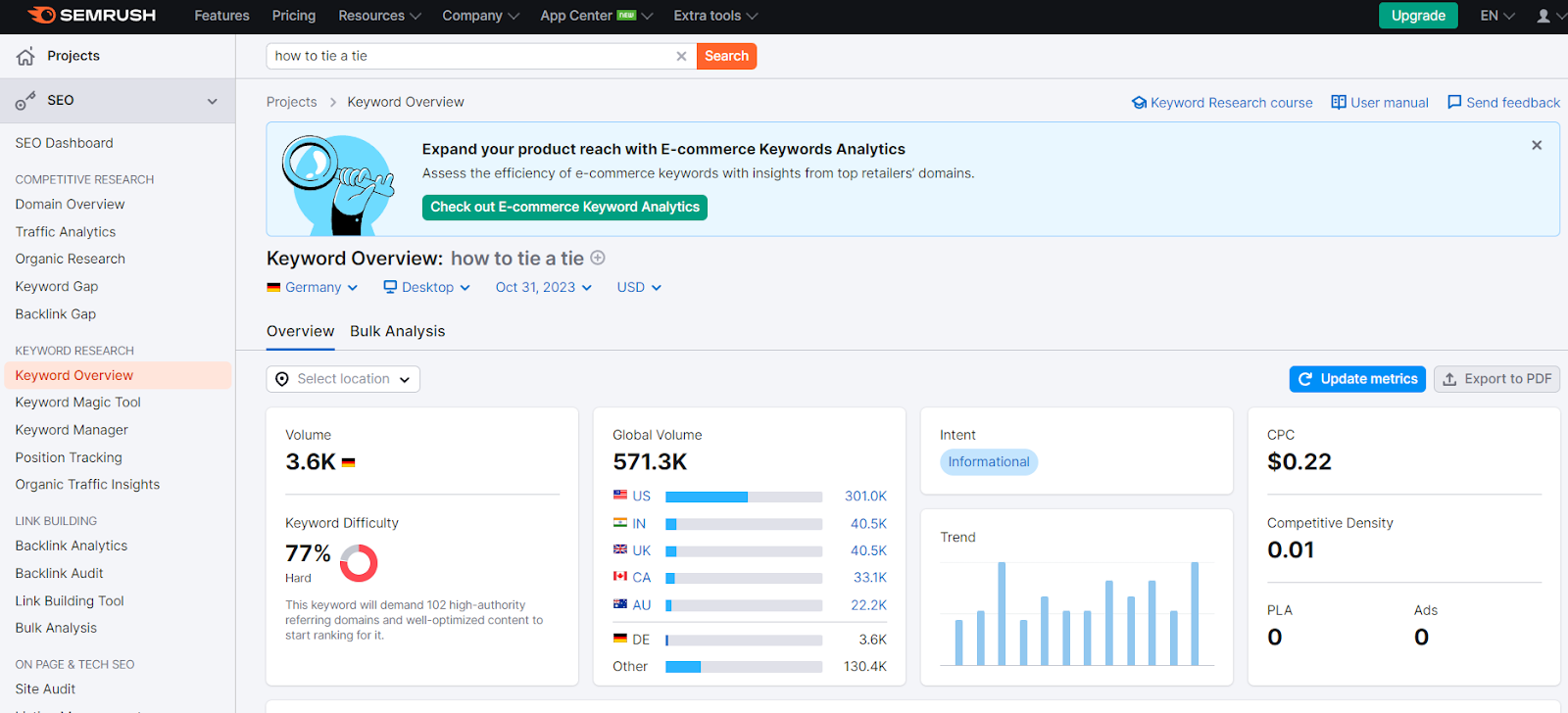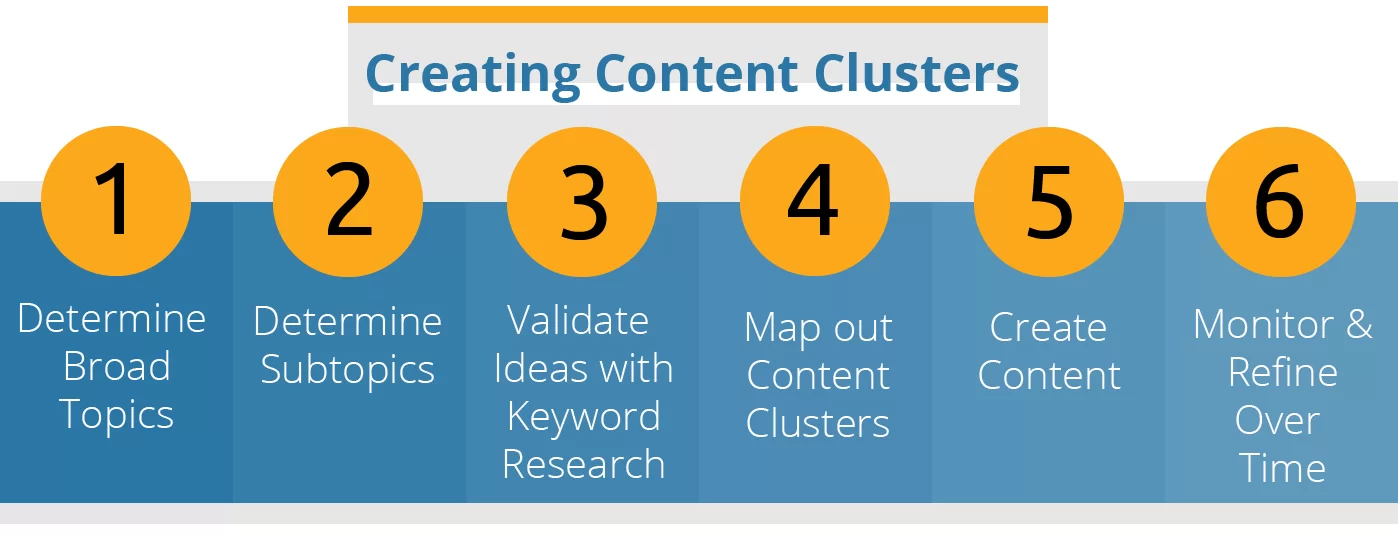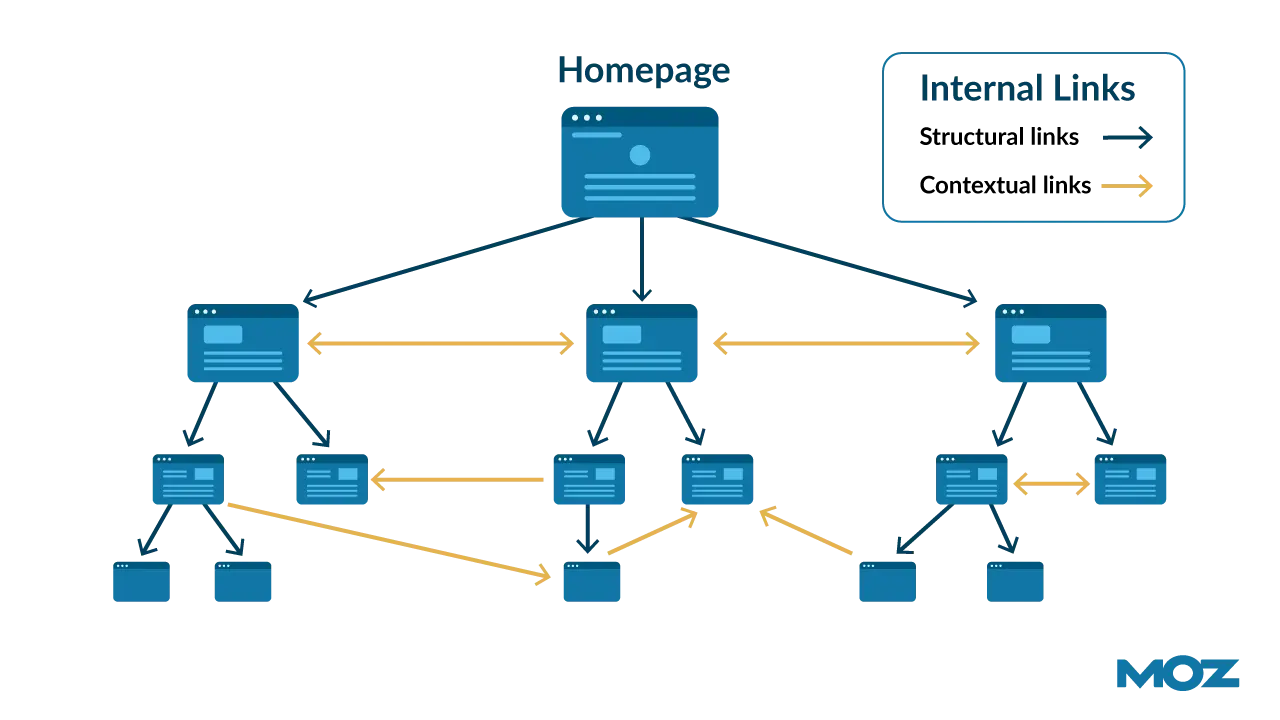This blog examines the Topic Cluster Strategy's effectiveness in content marketing and SEO, emphasizing its significant impact on organic search traffic and content success. It also shows how topic clusters are organized hierarchically and gives real-life examples to help explain the idea. Then adds how to make a good topic cluster content strategy, including researching keywords, making pillar content, developing cluster content, improving SEO, adding internal links, and promoting the content. It is emphasized how important it is to regularly update pillar content and how important pillar pages are for improving SEO, credibility, and authority in an industry. In short, it shows that the topic cluster strategy is a strong way to use content marketing to make websites better organized, improve user experience, and rank higher in search engines.
Did you know that businesses that effectively employ Topic Cluster Strategy experience a staggering 97% increase in their organic search traffic? And that 85% of marketers attribute their content success to the strategic use of topic clusters? This blog is your gateway to understanding how the Topic Cluster Strategy can transform your content marketing and SEO efforts. Let’s get started.
Table of Contents |

Understanding Topic Clusters
First things first, what exactly are topic clusters? In essence, they are an advanced SEO and content marketing strategy designed to boost your website's authority and visibility on search engines. A topic cluster consists of a central "pillar" page and multiple related content pieces, often referred to as "cluster content."
The pillar page covers a broad topic in depth, serving as the cornerstone of your cluster. Cluster content, on the other hand, revolves around specific subtopics related to the central pillar. The key here is to establish a strong internal linking structure between the pillar page and its cluster content, showcasing the interconnectedness of the topics.
Pillar Page: "Digital Marketing"
- Cluster Content 1: "Social Media Marketing"
- Subcluster Content 1: "Facebook Marketing"
- Subcluster Content 2: "Instagram Marketing"
- Subcluster Content 3: "Twitter Marketing"
- Cluster Content 2: "Content Marketing"
- Subcluster Content 1: "Blogging Strategies"
- Subcluster Content 2: "Video Marketing"
- Subcluster Content 3: "Email Marketing"
- Cluster Content 3: "SEO Strategies"
- Subcluster Content 1: "On-Page SEO"
- Subcluster Content 2: "Off-Page SEO"
- Subcluster Content 3: "Local SEO"
This structure visually demonstrates the hierarchy of topic clusters, where the pillar page serves as the central hub for broader content. In contrast, cluster content and subcluster content branches out into more specific areas.
Topic Cluster Examples
To better grasp the concept of topic clusters, let's look at some real-world examples:
Example 1: The Fitness Frontier
Pillar Page: "Ultimate Guide to a Healthy Lifestyle"
In this scenario, the "Ultimate Guide to a Healthy Lifestyle" serves as the central pillar page. It's a comprehensive resource that covers a broad topic: living a healthy lifestyle. This pillar page is likely filled with information about nutrition, exercise, mental well-being, and other aspects that contribute to overall health.
Cluster Content:
"Nutritional Nirvana: 10 Must-Have Nutrients"
This piece of cluster content zooms in on the nutrition aspect of the overarching "healthy lifestyle" theme. It provides detailed information about essential nutrients that contribute to a healthy diet. This content might discuss vitamins, minerals, macronutrients, and their role in maintaining good health.
"Cardio King: The Essence of Cardiovascular Workouts"
This cluster content piece delves into the world of cardiovascular workouts. It provides comprehensive guidance on the importance of cardio exercise in maintaining a healthy lifestyle. It could cover different types of cardio workouts, their benefits, and how to incorporate them into one's routine.
"Strength Unleashed: A Beginner's Guide to Strength Training"
This cluster content is all about strength training, another critical aspect of a healthy lifestyle. It's designed to be a beginner's guide, offering information on the benefits of strength training, basic exercises, and tips for those just starting out.
The magic of these cluster content pieces is in their connection to the pillar page. Each of them should have internal links leading back to the "Ultimate Guide to a Healthy Lifestyle." This internal linking reinforces the relationship between these subtopics and the overarching topic. It tells both users and search engines that this website is an authoritative source for all things related to a healthy lifestyle.
Crafting a Topic Cluster Content Strategy
Creating an effective topic cluster content strategy involves several steps:
1. Keyword Research

Keyword research is the foundation of your topic cluster strategy. It's essential to identify the most relevant and high-impact keywords in your industry. Tools like Google Keyword Planner, SEMrush, Ahrefs, and Moz Keyword Explorer can help you discover valuable keywords. Look for keywords with high search volume, low competition, and relevance to your niche.
2. Choose Your Pillar Topic
Your pillar topic is the heart of your strategy. It should be a broad, high-value subject that aligns with your business goals and represents an area where you want to establish authority. This topic will become the focal point of your content efforts, so choose wisely.
3. Create High-Quality Pillar Content
Once you've chosen your pillar topic, it's time to create an exceptional pillar page. This content should be comprehensive, informative, and engaging. It's the go-to resource for anyone seeking information on the chosen topic. Use a mix of text, visuals, and multimedia elements to make it appealing and informative. Your pillar page should leave no questions unanswered and serve as the ultimate resource in your niche.
4. Develop Cluster Content

Cluster content revolves around specific subtopics related to your pillar. These are more detailed and focused than the pillar content. Each cluster content piece should address a specific aspect or question within the broader pillar topic. Remember to link back to your pillar page, reinforcing the connection and demonstrating the depth of your content.
5. Optimize for SEO

SEO is the anchor of online visibility and success. Whether you're crafting pillar content or building out topic clusters, optimizing every piece of your digital real estate is paramount. Keyword optimization remains at the core of this strategy, as it ensures that your content aligns with what your audience is searching for. Effective use of keywords, both in the body of your content and metadata, is the foundation of SEO success. However, overloading your content with keywords can backfire, so strive for a natural and reader-focused approach.
Metadata, including title tags and meta descriptions, is your first chance to make a compelling impression in search results. A well-crafted title tag not only showcases your content but also incorporates your target keyword. Meanwhile, a concise yet engaging meta description can entice users to click through to your page. Properly structured header tags (H1, H2, H3, etc.) not only make your content more organized but also help search engines understand its structure and relevance.
Moreover, your content's mobile-friendliness is non-negotiable. As mobile device usage soars, Google and other search engines prioritize mobile-friendly websites in their rankings. Ensuring that your site offers a seamless user experience on all screen sizes is essential.
Page load times are another critical factor in SEO. Slow-loading pages frustrate users and lead to higher bounce rates, which can negatively affect your search rankings. Improving load times by compressing images, using browser caching, and minimizing code is vital for SEO success.
Finally, a user-friendly design encompasses overall website usability. A well-designed, intuitive website not only keeps users engaged but also signals to search engines that your site provides value. Clear navigation, readable content, and intuitive calls to action are all pivotal for enhancing user experience and, by extension, your SEO performance.
6. Internal Linking

Internal linking is a vital component of topic clusters. It's how you create a web of interconnected content. Ensure that there are clear, contextually relevant internal links within your cluster content that lead to the pillar page and vice versa. This not only aids in navigation but also strengthens the authority of your pillar page.
7. Promote Your Content
Creating fantastic content isn't enough; you also need to promote it. Share your content through various channels, such as social media, email marketing, and outreach to industry influencers and bloggers. Encourage sharing and engagement from your audience. The more visibility and backlinks your content receives, the more authoritative it becomes in the eyes of search engines.
Remember that your topic cluster content strategy is an ongoing process. Continuously analyze your performance, refine your content, and adapt to changes in your industry and search engine algorithms. By following these steps and consistently refining your strategy, you'll not only improve your search engine rankings but also provide valuable, comprehensive content for your audience, establishing your authority in your niche.
Read Also: Best SEO Practice for Magento: Your Reliable Guide
The Role of Pillar Pages in Topic Clusters
1. Pillar Pages as the Foundation
Pillar pages are the foundational element of your topic cluster strategy. They act as the central hub, providing in-depth coverage of a broad topic within your niche or industry. These pages are not just any content; they're authoritative, comprehensive resources designed to be the ultimate guide for anyone seeking information on the chosen topic.
The significance of the pillar page lies in its ability to act as the primary entry point for both users and search engines. When someone searches for a topic relevant to your pillar page, they should find it as a top search result. This means that your pillar page needs to be precisely optimized for SEO and tailored to provide the most valuable and informative content.
2. SEO Benefits of Pillar Pages
Search engines, such as Google, recognize the value of pillar pages. When your pillar page ranks well for your chosen broad topic, it can bring significant SEO benefits. Search engines view your pillar page as the authoritative source on the subject, which, in turn, improves your website's overall domain authority.
The clustering strategy comes into play when you create interconnected links between your pillar page and the related cluster content. These internal links indicate to search engines that there is a coherent and substantial body of content on the topic, which boosts your SEO efforts. When your pillar page and cluster content are closely related, the search engine's algorithm sees them as a holistic unit, further enhancing your ranking potential.
3. Enhancing Credibility
Pillar pages not only boost your SEO but also help enhance your credibility and reputation within your industry. By offering a well-researched, comprehensive, and informative pillar page, you position your website as a go-to resource. This can lead to increased trust from your audience, as they recognize your commitment to providing valuable information.
In addition, pillar pages demonstrate the depth of your knowledge and expertise on the subject matter. When visitors see that your website serves as a trusted source for detailed information, it builds trust and authority. This can be a game-changer for attracting and retaining an engaged audience.
4. Evolving and Updating Pillar Pages
It's important to note that pillar pages should not remain static. To maintain their authoritative status, they should be regularly updated to reflect the latest trends, data, and developments in the field. Google and other search engines favor fresh and up-to-date content, so revisiting and revising your pillar pages is a smart strategy.
In conclusion, pillar pages play a pivotal role in the success of your topic cluster strategy. They are the heart and the anchor of your content marketing efforts. When created effectively and continuously nurtured, they can significantly improve your SEO rankings, establish your website as an authoritative resource, and enhance your credibility within your industry. So, invest the time and effort into crafting exceptional pillar pages, and watch them soar your content marketing strategy to new heights.
Bottom line
The topic cluster strategy is a powerful approach to content marketing that can help you dominate your niche in the digital landscape. By creating pillar content supported by topic clusters, you can establish yourself as an industry authority and improve your search engine rankings.
So, ready to elevate your digital game? Our team at Do Communication specializes in a comprehensive suite of services tailored to boost your online presence. From SEO and SEM strategies that propel you up the search engine ranks to content marketing that establishes your industry authority, and website optimization ensuring your online space is a powerful asset – we've got you covered. Let's shape a tailored strategy that propels your brand to new heights. Explore our services and contact us now to soar your digital presence!
Frequently Asked Questions
Q1. What is Pillar Cluster Content Strategy?
The pillar cluster content strategy is a content marketing approach that involves creating a hierarchical structure of related content on a website. It revolves around a central "pillar" page, which serves as the crucial aspect of a specific topic. Cluster content, comprising subtopics related to the pillar, links back to the pillar page. This strategy aims to improve website organization, user navigation, and search engine optimization (SEO).
Q2. How do you create an effective topic cluster and pillar page?
To create an effective topic cluster and pillar page, follow these steps:
- Keyword Research: Identify relevant keywords for your industry.
- Choose Your Pillar Topic: Select a broad, high-value topic for your pillar page.
- Create High-Quality Pillar Content: Craft comprehensive, informative, and engaging pillar content.
- Develop Cluster Content: Create detailed content pieces, each focusing on a specific subtopic related to the pillar.
- Optimize for SEO: Ensure proper keyword usage and metadata optimization.
- Internal Linking: Establish a network of internal links connecting cluster content to the pillar page.
- Content Promotion: Share your content through various channels for maximum visibility.
Q3. How many topic clusters should I have?
The number of topic clusters you should have depends on the scale and breadth of your content marketing strategy. There's no fixed number, but it's essential to ensure that each topic cluster is relevant to your audience and industry. Start with a manageable number and expand as your content strategy grows.
Q4. Why use topic clusters?
Topic clusters offer several benefits, including improved organization of content, enhanced user experience, and better SEO. They help search engines understand the context of your content, leading to higher rankings. Topic clusters also encourage deeper user engagement by providing comprehensive information on a particular subject.
Q5. What are the main components of a topic cluster?
The main components of a topic cluster are:
- Pillar Page: The central, authoritative page that covers a broad topic.
- Cluster Content: Individual pieces of content focused on specific subtopics related to the pillar.
- Internal Links: A network of links connecting the cluster content to the pillar page and vice versa.


